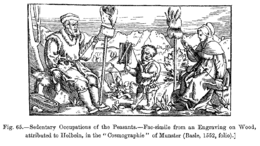| This article needs additional citations for verification. Please help improve this article by adding citations to reliable sources. Unsourced material may be challenged and removed. Find sources: "Cosmography" – news · newspapers · books · scholar · JSTOR (April 2024) (Learn how and when to remove this message) |
The term cosmography has two distinct meanings: traditionally it has been the protoscience of mapping the general features of the cosmos, heaven and Earth; more recently, it has been used to describe the ongoing effort to determine the large-scale features of the observable universe.
Premodern views of cosmography can be traditionally divided into those following the tradition of ancient near eastern cosmology, dominant in the Ancient Near East and in early Greece.
Traditional usage
The 14th-century work 'Aja'ib al-makhluqat wa-ghara'ib al-mawjudat by Persian physician Zakariya al-Qazwini is considered to be an early work of cosmography. Traditional Hindu, Buddhist and Jain cosmography schematize a universe centered on Mount Meru surrounded by rivers, continents and seas. These cosmographies posit a universe being repeatedly created and destroyed over time cycles of immense lengths.

In 1551, Martín Cortés de Albacar, from Zaragoza, Spain, published Breve compendio de la esfera y del arte de navegar. Translated into English and reprinted several times, the work was of great influence in Britain for many years. He proposed spherical charts and mentioned magnetic deviation and the existence of magnetic poles.
Peter Heylin's 1652 book Cosmographie (enlarged from his Microcosmos of 1621) was one of the earliest attempts to describe the entire world in English, and is the first known description of Australia, and among the first of California. The book has four sections, examining the geography, politics, and cultures of Europe, Asia, Africa, and America, with an addendum on Terra Incognita, including Australia, and extending to Utopia, Fairyland, and the "Land of Chivalrie".
In 1659, Thomas Porter published a smaller, but extensive Compendious Description of the Whole World, which also included a chronology of world events from Creation forward. These were all part of a major trend in the European Renaissance to explore (and perhaps comprehend) the known world.
Modern usage
In astrophysics, the term "cosmography" is beginning to be used to describe attempts to determine the large-scale matter distribution and kinematics of the observable universe, dependent on the Friedmann–Lemaître–Robertson–Walker metric but independent of the temporal dependence of the scale factor on the matter/energy composition of the Universe. The word was also commonly used by Buckminster Fuller in his lectures.
Using the Tully-Fisher relation on a catalog of 10000 galaxies has allowed the construction of 3D images of the local structure of the cosmos. This led to the identification of a local supercluster named the Laniakea Supercluster.
See also
- Johann Bayer
- Andreas Cellarius
- Cosmographia
- Julius Schiller
- Star cartography
- Chronology of the Universe
- Cosmogony
- Cosmology
- Timeline of knowledge about galaxies, clusters of galaxies, and large-scale structure
References
- Weinberg, Steven (1972). Gravitation and Cosmology: Principles and Applications of the General Theory of Relativity. Wiley. pp. 407–463. ISBN 978-0-471-92567-5.
- Visser, Matt (2005). "Cosmography: Cosmology without the Einstein equations". General Relativity and Gravitation. 37 (9): 1541–1548. arXiv:gr-qc/0411131. Bibcode:2005GReGr..37.1541V. doi:10.1007/s10714-005-0134-8. S2CID 119414427.
- Said, Khaled (2023-10-24). "Tully-Fisher relation". In Di Valentino, E; Brout, D. (eds.). Hubble Constant Tension. arXiv:2310.16053.
- Tully, R. Brent; Courtois, Hélène; Hoffman, Yehuda; Pomarède, Daniel (2014-09-03). "The Laniakea supercluster of galaxies". Nature. 513 (7516): 71–73. arXiv:1409.0880. Bibcode:2014Natur.513...71T. doi:10.1038/nature13674. ISSN 0028-0836. PMID 25186900. S2CID 205240232.